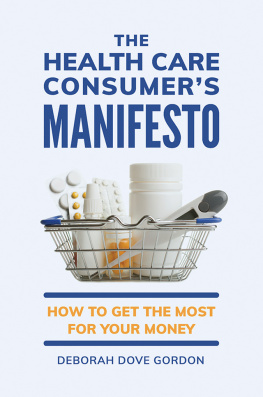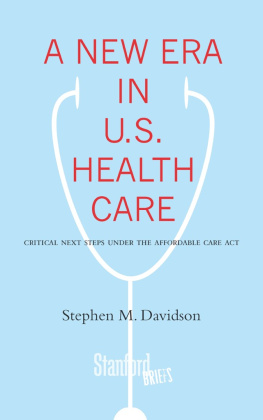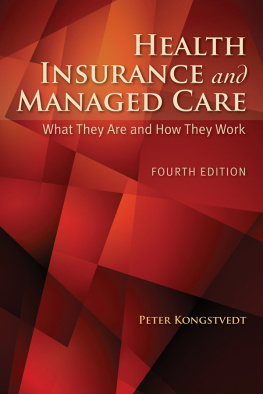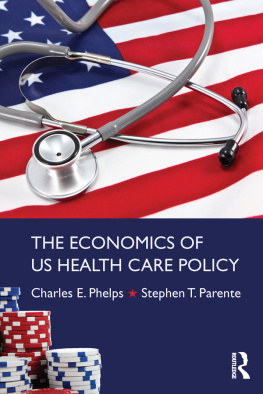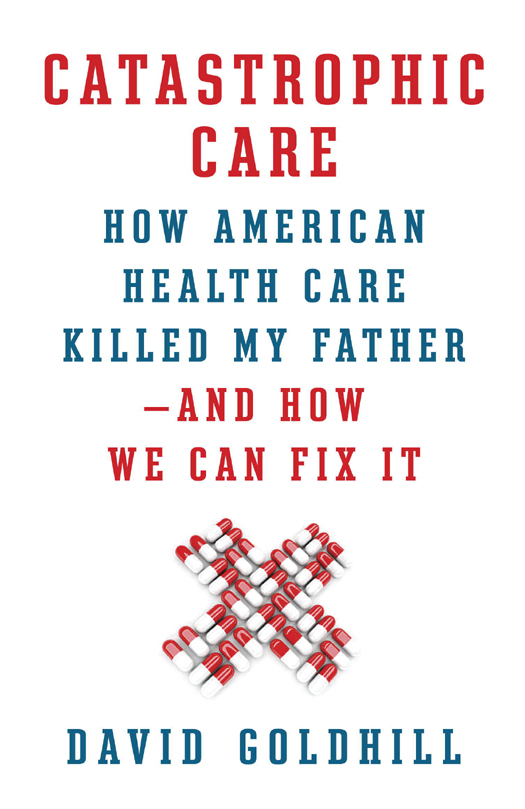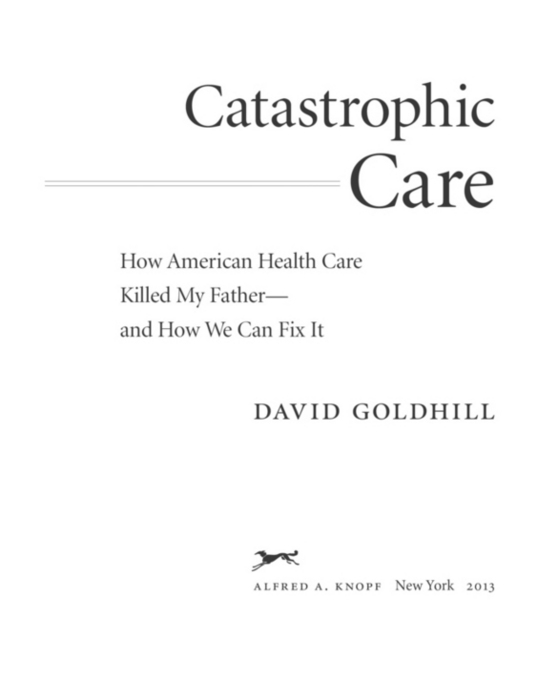THIS IS A BORZOI BOOK
PUBLISHED BY ALFRED A. KNOPF
Copyright 2013 by David Goldhill
All rights reserved. Published in the United States by Alfred A.
Knopf, a division of Random House, Inc., New York, and in Canada by Random House of Canada Limited, Toronto.
www.aaknopf.com
Knopf, Borzoi Books, and the colophon are registered trademarks of Random House, Inc.
Grateful acknowledgment is made to Chris Rock for permission to reprint an excerpt from Chris Rock: Never Scared (HBO Films, 2004). Reprinted by permission of the artist.
Library of Congress Cataloging-in-Publication Data
Goldhill, David.
Catastrophic care : how American health care killed my fatherand how we can fix it / David Goldhill.
pages cm
eISBN: 978-0-307-96155-6
1. Medical care, Cost ofUnited States. 2. Health insuranceUnited States. 3. Health services accessibilityUnited States. 4. Medical errorsUnited States. I. Title.
RA 410.53. G 655 2013 362.1042580681dc23 2012028745
Jacket photograph: Alamy Creativity/Alamy
Jacket design by Chip Kidd
v3.1
In memory of my father, the doctor
Contents
INTRODUCTION
How American Health Care Killed My Father
CHAPTER 1 Island-Speak
Eleven strange things we all believe about health care
CHAPTER 2 The Hidden Beast
The myth of affordable care
CHAPTER 3 The Disconnect
The absence of consumers in health care
CHAPTER 4 The Fallacy
Why we always think we need more health care
CHAPTER 5 The Seduction
Forty-five years of Medicare
CHAPTER 6 The Mirage of Efficiency
Why the cost curve wont bend
CHAPTER 7 The Tyranny of Rules
Why everything is so complicated
CHAPTER 8 Last Gasp
The ACA and the insurance fixation
CHAPTER 9 In Search of Balance
How should we pay for health care?
CHAPTER 10 Green Shoots
Foundations of a better system
CHAPTER 11 Transition
Can we get there from here?
AFTERWORD
Mae West Didnt Know Health Care
APPENDIX 1
Unintended Consequences: Could the ACA reduce the number insured?
APPENDIX 2
Dj Vu: The ACA and the previously failed new cost controls
APPENDIX 3
Shifting the Governments Focus to Better Health
Introduction
How American Health Care Killed My Father
B ecky is a twenty-six-year-old whos worked in my companys marketing department for three years. Its her first job out of school, and shes done very well. Shes smart, ambitious, and poised, and her future is promising.
Becky describes herself as a bit hypochondriacal, so she sees two primary care physicians a year. But shes generally healthy and has no major health care needs. With the insurance plan shes chosen, she can see any doctor she wants, but the annual deductible doubles, from $250 to $500, when she goes out of network. Most of the treatments she uses count as preventive care, which now has no cost sharing. So with her share of the companys insurance premiums and her out-of-pocket expenses, health care will cost Becky just about $2,500 a year. That may be a bit more than she would like, but all things considered, its not terrible for someone just starting out, right?
Wrong.
. For now, what you urgently need to understand is that beginning on the first day of her working career, the cost of health care will be the major constraint on Beckys standard of living matchingmuch less, surpassingthat of her parents.
And it will only get worse for Becky as she settles down and starts a family. Because, as Ill show you, even if we somehow eliminate the explosive growth in health care costsliterally reduce growth to zeroour current system already ensures that Becky will pay well more than $1.2 million into it over her lifetime. If Beckys hoping the new Affordable Care Act will somehow reduce her cost, then shes unaware that the administrations own projections show per capita health costs rising by 5 percent per year over the next ten years (which would mean her lifetime contribution to the system will be $1.8 million, even assuming that after those ten years health costs dont grow at all). All this assumes she never has a major illness, in which case she will almost certainly pay much more.
None of this is on Beckys radar screen today. Although shes probably spending more this year on health care than on anything else (except maybe big-city apartment rent), and while she describes herself as a true bargain shopper, Becky has no awareness at all of what health care is really costing her. She thinks about her health care benefits, not about her health care costs.
I started thinking about health care because of a personal tragedy: almost five years ago, my father died from a hospital-borne infection he acquired in the intensive care unit of a well-regarded New York hospital. Dad had just turned eighty-three and had a variety of the ailments common to men of his age. But he was still working the day he walked into the hospital with pneumonia. Within thirty-six hours, he had developed sepsis. Over the next five weeks in the ICU, a wave of secondary infections, all contracted in the hospital, overwhelmed his defenses and caused him great suffering. But although his death was a deeply personal and unique tragedy for me and my family, my dad was merely one of a hundred thousand Americans who died that year as a result of infections picked up in hospitals.
One hundred thousand preventable deaths! Thats more than double the annual number of people killed in car crashes, five times the number murdered, twenty 9/11s. Each and every year!
A few weeks after my fathers death, The New Yorker ran an article by Atul Gawande profiling the efforts of Dr. Peter Pronovost to reduce the incidence of fatal hospital-borne infections. Pronovosts solution? A simple checklist of ICU protocols for physicians and nurses governing hand washing and other basic sterilization procedures. Hospitals implementing Pronovosts checklist achieved almost instantaneous success, reducing deaths from hospital infections by more than half. But many physicians rejected the checklist as an unnecessary and belittling intrusion, and many hospital administrators were reluctant to push this simple improvement on them. Gawandes article chronicled Pronovosts travels around the country as he struggled to persuade hospitals to embrace his reforms.
It was a heroic story, but it was also deeply unsettling. Why did Pronovost need to beg hospitals to adopt an essentially cost-free idea that saved so many lives? In an industry that loudly protests the high cost of liability insurance and the injustice of our tort system, why did a simple and effective technique require such extensive lobbying?
And what about usthe patients? Our nation is quick on the draw to close down an imperfectly assembled theme park ride or a business serving an E. coliinfused hamburger. Why do we tolerate the carnage inflicted by our hospitals? The hundred thousand deaths from infections are compounded by a litany of routine mistakes that create preventable blood clots, drug dosage and prescription errors, and any number of other oversights. All this adds up to an estimated two hundred thousand Americans killed each year by medical mistakes. A single fatal accident at a school or even a nightclub will make headlines in your hometown newspaper. How did Americans learn to accept hundreds of thousands of deaths from avoidable medical mistakes as an inevitability of the system?


